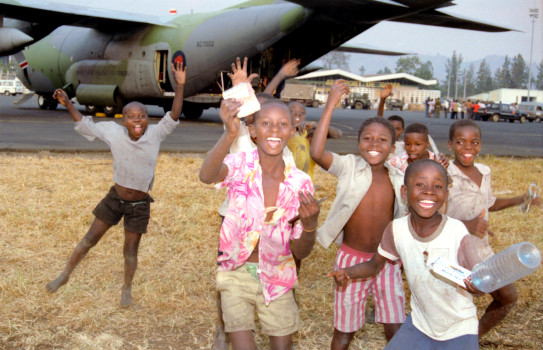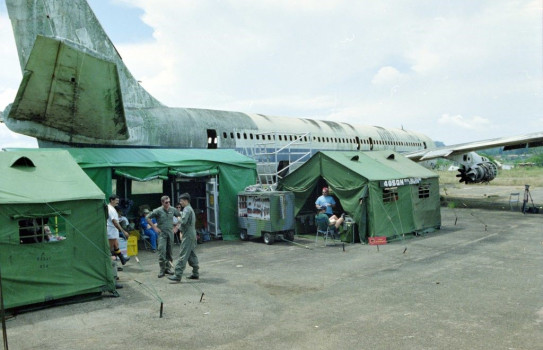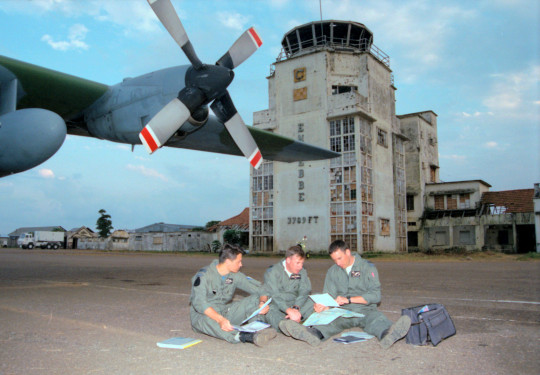The right people at the right time: The RNZAF mission to Rwanda
In July 1994 the Air Force was at the forefront of the rescue effort during one of the worst humanitarian disasters of the 20th century. They were the right people at the right time, and the C-130(H) Hercules was the aircraft that got the job done.
15 November, 2024
In April of that year, the Rwandan Government, dominated by the majority Hutu tribe began a brutal genocidal campaign against its opponents, in particular, the smaller Tutsi tribe, killing about half a million people. The Tutsis fought back in the form of the Rwandan Patriotic Front (RPF). The RPF defeated the Government forces and about two million Hutus fled over the border to neighbouring countries to avoid retribution by the RPF.
The humanitarian crisis deepened as thousands started to suffer from hunger and disease.
The United Nations’ refugee agency UNHCR was tasked with providing relief. The New Zealand Government committed to providing money and a C-130H Hercules to assist in transporting aid to the struggling refugees through the auspices of the UNHCR.

Hercules on the tarmac at Goma, Zairewith local children.
The 36-strong detachment, led by Wing Commander (WGCDR) Graham Lintott, flew out of New Zealand on July 25 in Hercules NZ7002, captained by Squadron Leader Chris Mehlhopt.
The Hercules arrived in Nairobi three days later before proceeding to Entebbe airport in Uganda to begin operations on the newly named Operation Reforge.
The Air Force team consisted of two full aircrews, loadmasters, maintenance personnel, security staff, a medic, a communications operator and an administration team.
Their tented camp was set up in the shelter of a wrecked airliner, destroyed in the famous hijacking at Entebbe in 1976. Work began almost immediately, on August 4 with flights to Goma in Zaire (now the Democratic Republic of Congo), where many of the refugees were concentrated. There was little order at Goma with locals using the runway as a road and children playing close by.
With almost 2000 people dying each day in the camps, time was of the essence and the crews and ground staff worked long hours and made frequent flights into Goma and other airfields.

No. 40 Squadron’s base at Entebbe Airport in Uganda. The squadron used a wrecked airliner as a strategic windbreak
Flights into Bukavu proved easier and were as vital, given nearly 400,000 people were sheltering around the town. The Air Force aid to Bukavu was especially timely, as WGCDR Lintott reported: “Our flight was the first food they’d had delivered in a week, so they were pretty desperate and pleased to see us.”
To increase the speed of delivery, pallets were delivered in a combat off-loading manner, by gently pushing them off the loading ramp onto the ground as the aircraft moved along the ground.
All of this was done many thousands of kilometres from home. The types of cargo carried included beans, corn soya/mash, cooking oil, biscuits and six British Land Rovers with a communications team.
On 20 September 1994, nearly two months after deployment, members of the team returned home to Base Whenuapai and their families. Remarkably, the C-130 had delivered 3.5 million pounds of freight for refugee relief in just two months, as well as carrying over 250 passengers.
This was the highest total of any participant in the relief operation and amounted to a pound of freight for each member of the New Zealand population at that time. NZ7002 had also flown 10 per cent of the allotted hours for the C-130 annually, in other words, five times as many as it would have done in the same period normally.
The legacy of Operation Reforge was the sheer number of lives saved. As Group Captain Bruce Ferguson, the Base Commander at Whenuapai put it: “We were the right people there at the right time."
